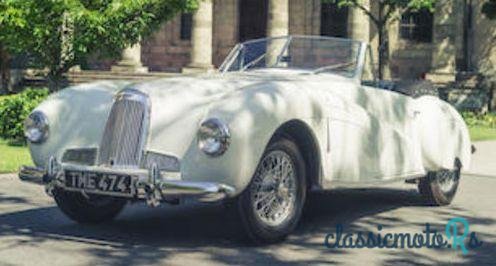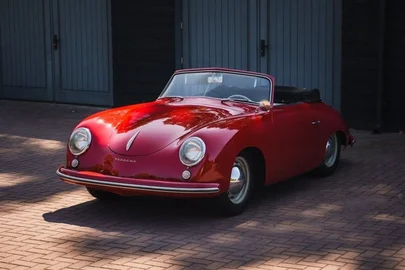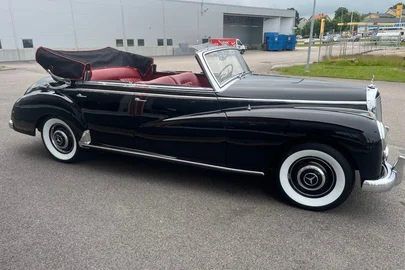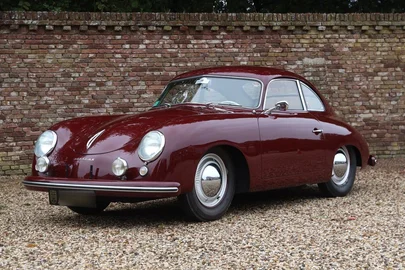
1948' Aston Martin Two Litre
Diese Anzeige melden!Bewerte!Lesezeichen setzen
£220,000Veröffentlicht 5 September 2018ID: MzbTZg
Abgelaufen
7 Jahre, 3 Monate her
7 Jahre, 3 Monate her
Information from the owner
Karosserie: Sportwagen
Alter: 70 Jahre
Außenfarbe: Braun
Verkäuferkommentare zu 1948' Aston Martin Two Litre
Bonhams are delighted to offer at our forthcoming Collectors', Competition and Fine Motor Car Auction on Saturday 8th September 2018 at The Goodwood Revival Meeting, Chichester, 115 select motor cars.
THE EARLS COURT MOTOR SHOW
1948 ASTON MARTIN TWO LITRE SPORTS DROPHEAD COUPÉ (DB1)
REGISTRATION NO. TME 474
CHASSIS NO. AMC48/7
*The first post-war Aston Martin model
*First owned by Sir David Brown
*One of only 15 production cars made
*Works experimental car
*Offered from a private collection in Japan
£220,000 - 280,000
€250,000 - 310,000
'The modern Aston Martin is a most interesting car. Its 9ft 0in wheelbase chassis is of entirely specialised construction, a rectangular section steel tube structure being used, which also forms a frame for the bodywork ... a very high degree of road-holding has been achieved - the Aston Martin is one of our most outstanding cars in this respect...' - Motor Sport, November 1948.
One of only 15 made, this Two Litre Sports is a fine example of the model that ushered in the 'David Brown' era at Aston Martin. Successful industrialist David Brown had bought the struggling Aston Martin concern in 1946, having seen a 'High Class Motor Business' advertised for sale in The Times newspaper with an asking price of £30,000. The following year he added Lagonda to his expanding motor-manufacturing empire, a move that made the latter's twin-overhead-camshaft, 2.6-litre six available for a new Aston Martin sports car.
When David Brown bought Aston Martin he acquired the Atom - a 2.0-litre four-cylinder prototype intended for post-war production - plus 'a few rusty old machine tools and the services of the Atom's designer, Claude Hill, who was very good...'. The chassis of the Two Litre Sports was a direct development of the Atom's, being of tubular construction and featuring independent front suspension by means of trailing arms, and a well-located live rear axle. Coil springs were used all round, plus a torsion bar at the front. A departure from Aston Martin's customary overhead-camshaft type, the 1,970cc pushrod overhead-valve engine was intended to be more reliable and easier to service. The gearbox was a David Brown four-speed unit, and there were Girling drum brakes all round.
With the Lagonda purchase had come the services of their remarkably talented body stylist, Frank Feeley. Feeley designed the drophead coupé body for the Two Litre Sports, based on sketches he had made pre-war for the Lagonda V12. This modern, streamlined shape was very different from the traditional Aston Martin style, and its trend-setting influence can be detected in other handsome contemporary designs such as the Sunbeam Alpine. A foretaste of future glories was provided in 1948 when a stripped-for-racing Two Litre Sports won the Spa 24 Hours Race.
But David Brown was pressing ahead with the new DB2, with its 2.6-litre six-cylinder engine that had been designed by Willie Watson while the great W O Bentley was Lagonda's Chief Engineer. With the DB2 ready for release, production of the Two Litre Sports (retrospectively known as the 'DB1') was halted in mid-1950 after only 15 cars had been made. It is thus the rarest of all the 'David Brown' Aston Martin production models.
The car offered here, chassis number '7', was displayed on the Aston Martin stand at the 1948 Earls Court Motor Show, and then was used by the works for experimental purposes while owned privately by David Brown. Its history for the next 30-40 years is not known, though the AMOC Register records an appearance at the Greenwich concours in 1980 when the car was entered by someone called Whitaker, winning the Denman Trophy.
In 1989, this car was imported into Japan by the Azuba Motor Co Ltd, which had been appointed as an authorised importer by Aston Martin in 1986. During the boom years of the Japanese economy in the late 1980s/early 1990s, the Aston formed part of the private collection of Mr Kitaro Watanabe, at that time the world's sixth richest man according to Forbes magazine. During the 2000s, the Aston participated in various minor historic car events in Japan. Maintenance and servicing were carried out by Azuba Motor Co Ltd.
A possibly once-in-a-lifetime opportunity for the serious collector to own one of these ultra-rare and historic Aston Martins.
Should the vehical remain in the EU, local import taxes of 5% will be applied to the hammer price.
THE EARLS COURT MOTOR SHOW
1948 ASTON MARTIN TWO LITRE SPORTS DROPHEAD COUPÉ (DB1)
REGISTRATION NO. TME 474
CHASSIS NO. AMC48/7
*The first post-war Aston Martin model
*First owned by Sir David Brown
*One of only 15 production cars made
*Works experimental car
*Offered from a private collection in Japan
£220,000 - 280,000
€250,000 - 310,000
'The modern Aston Martin is a most interesting car. Its 9ft 0in wheelbase chassis is of entirely specialised construction, a rectangular section steel tube structure being used, which also forms a frame for the bodywork ... a very high degree of road-holding has been achieved - the Aston Martin is one of our most outstanding cars in this respect...' - Motor Sport, November 1948.
One of only 15 made, this Two Litre Sports is a fine example of the model that ushered in the 'David Brown' era at Aston Martin. Successful industrialist David Brown had bought the struggling Aston Martin concern in 1946, having seen a 'High Class Motor Business' advertised for sale in The Times newspaper with an asking price of £30,000. The following year he added Lagonda to his expanding motor-manufacturing empire, a move that made the latter's twin-overhead-camshaft, 2.6-litre six available for a new Aston Martin sports car.
When David Brown bought Aston Martin he acquired the Atom - a 2.0-litre four-cylinder prototype intended for post-war production - plus 'a few rusty old machine tools and the services of the Atom's designer, Claude Hill, who was very good...'. The chassis of the Two Litre Sports was a direct development of the Atom's, being of tubular construction and featuring independent front suspension by means of trailing arms, and a well-located live rear axle. Coil springs were used all round, plus a torsion bar at the front. A departure from Aston Martin's customary overhead-camshaft type, the 1,970cc pushrod overhead-valve engine was intended to be more reliable and easier to service. The gearbox was a David Brown four-speed unit, and there were Girling drum brakes all round.
With the Lagonda purchase had come the services of their remarkably talented body stylist, Frank Feeley. Feeley designed the drophead coupé body for the Two Litre Sports, based on sketches he had made pre-war for the Lagonda V12. This modern, streamlined shape was very different from the traditional Aston Martin style, and its trend-setting influence can be detected in other handsome contemporary designs such as the Sunbeam Alpine. A foretaste of future glories was provided in 1948 when a stripped-for-racing Two Litre Sports won the Spa 24 Hours Race.
But David Brown was pressing ahead with the new DB2, with its 2.6-litre six-cylinder engine that had been designed by Willie Watson while the great W O Bentley was Lagonda's Chief Engineer. With the DB2 ready for release, production of the Two Litre Sports (retrospectively known as the 'DB1') was halted in mid-1950 after only 15 cars had been made. It is thus the rarest of all the 'David Brown' Aston Martin production models.
The car offered here, chassis number '7', was displayed on the Aston Martin stand at the 1948 Earls Court Motor Show, and then was used by the works for experimental purposes while owned privately by David Brown. Its history for the next 30-40 years is not known, though the AMOC Register records an appearance at the Greenwich concours in 1980 when the car was entered by someone called Whitaker, winning the Denman Trophy.
In 1989, this car was imported into Japan by the Azuba Motor Co Ltd, which had been appointed as an authorised importer by Aston Martin in 1986. During the boom years of the Japanese economy in the late 1980s/early 1990s, the Aston formed part of the private collection of Mr Kitaro Watanabe, at that time the world's sixth richest man according to Forbes magazine. During the 2000s, the Aston participated in various minor historic car events in Japan. Maintenance and servicing were carried out by Azuba Motor Co Ltd.
A possibly once-in-a-lifetime opportunity for the serious collector to own one of these ultra-rare and historic Aston Martins.
Should the vehical remain in the EU, local import taxes of 5% will be applied to the hammer price.




